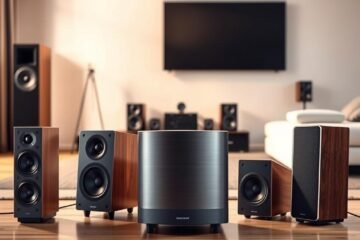Nearly 40% of American homes now have a voice-controlled device. These devices have changed how we live. The best smart speakers 2025 do more than just take voice commands. They are the heart of our homes, making our lives easier.
Today’s voice assistants can control lights, temperature, and even security. You can ask Alexa about the weather, have Google Assistant make a shopping list, or play music with Siri. These AI speakers make our lives more convenient.
Our guide helps you find the right home automation for your space. We’ve tested each option to ensure they meet your needs. Our picks offer top sound quality, easy controls, and work well with other smart home technology.
Ready to upgrade your home? Let’s look at the devices that will shape the future of connected homes.
Key Takeaways
- Voice-controlled devices now reach nearly 40% of American households
- Modern smart speakers function as central hubs for home automation
- Sound quality has dramatically improved in the latest devices
- Different assistants (Alexa, Google, Siri) offer unique ecosystem advantages
- Room-specific features optimize performance in kitchens, bedrooms, and living spaces
- Multi-room audio capabilities create seamless experiences throughout your home
The Evolution of Smart Speakers in 2025
The smart speaker revolution of 2025 is a big change. It moves from simple voice commands to smart helpers that know what you need. These devices have grown from basic weather checks and music players to smart hubs of modern homes.
This change is a major leap in wireless speaker innovations. It changes how we live in our homes.
Today’s smart speakers do more than just follow commands. They understand what you mean, learn your likes, and work with many parts of your life. The market has grown, with devices made for different places and uses.
From Voice Assistants to Ambient Computing
The shift from simple voice assistants to ambient computing is huge. Early smart speakers needed specific words and could only do a few things. Now, they understand natural speech and keep track of what you’re saying.
Modern AI home audio systems can tell who’s talking. So, when you ask about your day, it knows it’s you and shows your schedule.
“We’ve moved beyond the era of giving simple commands to our devices. The future of voice assistants is ambient intelligence—technology that understands the nuances of human communication and anticipates needs before they’re expressed.”
Now, your smart speaker can do things like turn on lights when you walk in. It can even play your favorite music after a workout. These smart actions are the future of voice assistants.
Love voice control? Add smart audio glasses for hands-free notes, timers, and quick replies on the go.
Why Space-Specific Selection Matters
As smart speakers got better, makers realized different rooms need different things. Your kitchen and bedroom have different needs. This led to devices made for specific places.
Every room sounds different. Kitchens echo, while bedrooms absorb sound. Smart speakers now adjust to these differences for better sound.
Privacy also changes by room. Bedrooms might need extra privacy, while living rooms are for group talks. This makes sure you get the right features for each room.
Durability is also key. Smart speakers have complex parts that wear out. But some, like Sonos, are built to last longer. This is important for keeping your home audio system running smoothly.
The power needs of speakers also vary. Kitchen and living room speakers often stay plugged in. Bedroom and portable speakers focus on battery life. This is key for whole-home audio systems.
As we look ahead to 2025, smart speakers will keep getting better. They’ll be made for specific needs, making choosing the right one more important than ever.
Why Room Placement Matters When Choosing a Smart Speaker
Choosing the right smart speaker isn’t just about looks. It’s about sound quality, how well it works, and keeping your privacy. What works in your kitchen might not be good for your bedroom or office. Knowing how your environment affects a speaker’s performance helps you pick the best one for each room.
Today’s ambient computing speakers are made to fit in with your home while helping you out. But, how well they work depends a lot on where you put them. A speaker that sounds great in your living room might not be as good in a small bathroom.
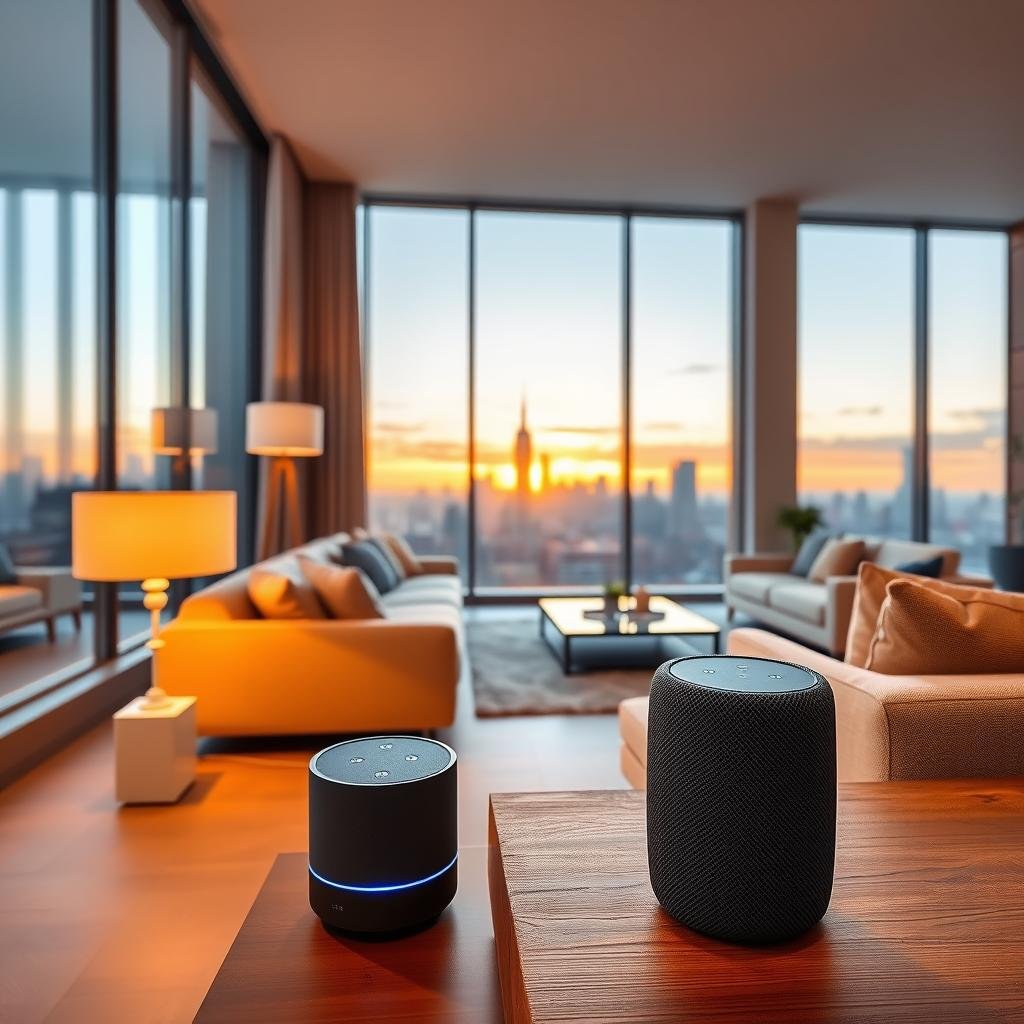
Smart speakers need to sound good and catch your voice commands, even from far away or over background noise. This makes where you put them even more important than with regular speakers.
Acoustic Considerations by Room Type
Every room in your home has its own sound challenges. The size, shape, and materials of each room affect how sound travels. This can make your immersive sound experience better or worse.
Kitchens have hard surfaces like countertops and tile floors. These surfaces bounce sound, making it sound harsh or tinny. Look for speakers with adaptive EQ to handle these reflective environments.
Bedrooms need speakers with night modes and softer sounds. The soft stuff in these rooms absorbs sound, making it warmer. Choose speakers that can direct sound if you share your bedroom.
Living rooms need speakers that can fill the space with balanced sound. Many premium speakers now use room-sensing tech to adjust sound based on your space. Some even use beamforming to direct sound to where you’re sitting.
- Bathrooms: Choose water-resistant models with clear audio that can overcome shower noise
- Home offices: Prioritize speakers with excellent microphones for clear video calls
- Dining areas: Look for speakers with 360-degree sound projection for table conversations
Functionality Needs Across Different Spaces
Smart speakers for kitchen areas need to hear commands over kitchen noise. Look for models with at least six microphones for reliable performance in these challenging environments.
Living room speakers should fill the room with sound and recognize different voices. This is important for family gatherings and entertainment. The best models can tell who’s speaking and respond personally.
Bedroom speakers should have good alarm functions and gentle wake-up features. Many now offer ambient sounds to help you sleep and wake up naturally. Some even track your sleep quality.
Home office speakers should work well with productivity tools and video calls. Next-gen voice control lets you manage your day without touching your keyboard.
The difference between a smart speaker and a regular bookshelf or portable Bluetooth speaker is that a smart speaker has a microphone that listens for voice commands, as well as a built-in voice assistant that fields your requests.
Privacy and Connectivity Factors
Privacy matters a lot when choosing a speaker, depending on where you plan to use it. Bedroom and bathroom speakers should have strong privacy controls, like mute buttons and lights that show when microphones are on. Some high-end models even process data locally to reduce cloud transmission.
Living room and kitchen speakers focus on connectivity for streaming and smart home control. These areas are often the center of your connected devices. So, it’s important to have reliable Wi-Fi. Look for speakers that work with Thread, Matter, or Zigbee for future smart home needs.
Network needs change based on where you place your speakers. Devices in weak Wi-Fi areas might need mesh extenders or ethernet options. For homes with multiple floors, placing speakers strategically can extend your smart home network.
Think about these connectivity factors when placing speakers:
- Distance from your router or mesh nodes
- Potential interference from other electronic devices
- Physical barriers like walls and floors that may weaken signals
- Proximity to other smart home devices that need control
By considering the sound, function, and connectivity needs of each room, you can find smart speakers that improve your life. The right speaker in the right place becomes a key part of your smart home.
What Defines the Best Smart Speakers in 2025
In 2025, the top smart speakers blend advanced audio tech, AI smarts, and easy smart home links. They’ve grown from simple voice gadgets to music, weather, and more. They manage shopping lists and calls, becoming key digital helpers.
The market has grown, with clear differences between high-end and budget speakers. Let’s look at what makes a speaker stand out in this fast-changing field.
Sound Quality Advancements
Smart speakers’ sound has greatly improved in 2025. What were once poor speakers now offer great sound for all listeners.
Spatial audio is a big leap. It creates a 3D sound that’s amazing in smart speakers for living room use. It feels like you’re surrounded by sound, even with just one device.
Adaptive room acoustics are now common in top models. These speakers adjust sound based on your room’s acoustics. This ensures great sound in any space.
The miniaturization of acoustic components has been nothing short of revolutionary. We’re now able to extract sound quality from a 6-inch speaker that would have required floor-standing towers just five years ago.
Even cheap smart speakers have improved a lot. Models under $100 now offer great sound quality, something expensive speakers had before.
AI Assistant Capabilities
The brains behind today’s best voice assistant speaker options have grown a lot. They can understand us better, making conversations feel more natural.
These assistants now remember conversations, understanding follow-up questions without needing to repeat info. Ask about the weather, then ask about tomorrow, and they get it.
Voice recognition has also gotten better. The best systems can tell who’s speaking, giving personalized info without needing to say who you are.
The Alexa vs Google Assistant rivalry has led to big improvements. Both offer:
- Proactive help based on your habits
- Emotion detection for better responses
- Natural, flowing conversations
- Special knowledge in areas like cooking and fitness
Apple’s Siri has also made big strides, focusing on privacy and keeping data local.
Smart Home Integration Features
The best smart speakers in 2025 are hubs for your whole smart home. This feature sets them apart from basic speakers.
They now work with many devices thanks to Matter and Thread. This means your multi-room audio setup works better and farther.
Scene management has also improved. Now, a simple command can control many devices at once. Say “Good morning” and your home adjusts while giving you news.
The table below shows how different platforms compare in smart home features:
| Feature | Amazon Echo | Google Nest | Apple HomePod | Sonos |
|---|---|---|---|---|
| Matter Support | Full | Full | Full | Partial |
| Thread Border Router | Yes | Yes | Yes | No |
| Local Processing | Partial | Partial | Extensive | Limited |
| Device Compatibility | 140,000+ | 100,000+ | 80,000+ | 75,000+ |
| Hub Functionality | Built-in | Built-in | Built-in | Requires Bridge |
Even budget smart speakers now control your smart home well. They might lack some features, but they can control lights and thermostats with your voice.
Energy management is a key feature now. Smart speakers can track energy use and suggest ways to save. They can even adjust devices to save money during peak hours.
As we move through 2025, sound quality, AI smarts, and smart home links are key. The best speakers do well in all areas. But some might focus more on one thing to meet certain needs.
Our Selection Criteria and Testing Process
To find the best smart speakers for 2025, we used a detailed evaluation method. We tested dozens of speakers in different settings. This way, our recommendations are based on real-world use, not just specs.
Our team has reviewed smart speakers for over a decade. We created a smart speaker buying guide to help you choose the right one. Whether you prefer Amazon Alexa or Google Assistant, we’ve got you covered.
How We Tested and Evaluated
We start by setting up each speaker and checking how easy it is to use. Even the most advanced home automation speaker should be simple for everyone. This step helps us find speakers that make your life easier.
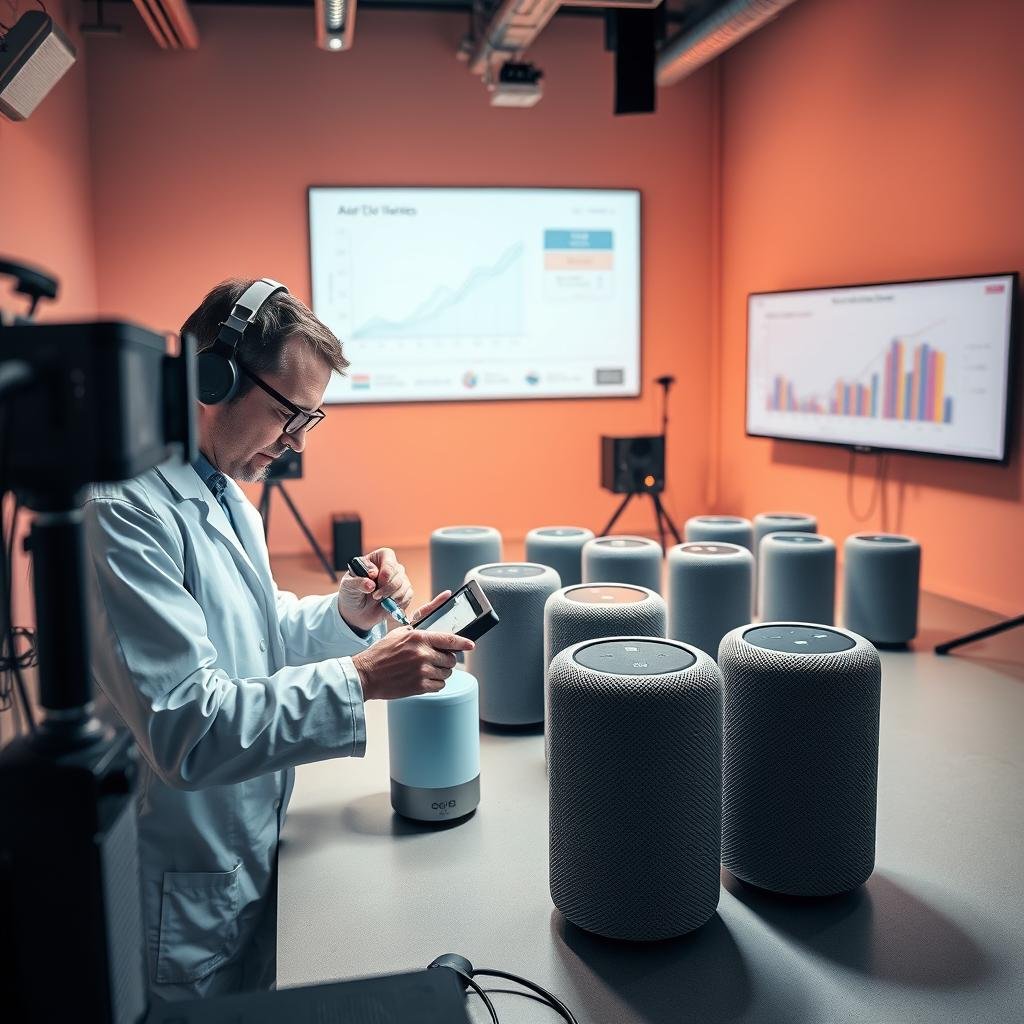
We tested sound quality with a wide range of music. This shows how well each smart speaker for music handles different types of music. We focus on bass, mid-range, and high-frequency details for a great listening experience.
We tested voice recognition in real-world conditions. We gave commands from different distances and with various background noises. This shows which speakers work best, even when it’s loud.
We also tested smart home integration. We connected each speaker to devices like lights and cameras. This shows which speakers work best as central hubs for your home.
Testing speakers in different rooms is key. We tested speakers in various rooms to see how they perform. This helps us find the best speaker for your space, whether it’s a bedroom or living room.
For speakers with displays, we looked at screen quality and design. The best smart speaker with display should be easy to read and use. We tested screens in different lighting to ensure they’re visible all day.
Balancing Performance and Value
We know that great sound is important, but so is value. Our guide includes options at all price points. We look at features and performance to find the best value for you.
We also consider long-term reliability. We check updates, warranties, and user reports. A speaker that sounds great but doesn’t get updates is not a good value.
Ecosystem compatibility is important to us. We check how well each speaker works with its ecosystem and third-party services. This helps you avoid problems after you buy.
Privacy is a big part of our testing now. We look at mute functions, data storage, and user control. Speakers that protect your privacy while being functional rank higher with us.
Our recommendations are based on performance, value, and versatility. We focus on finding the best speaker for your space. Our guide is practical, not just a showcase of tech.
Speaker performance also depends on wireless speed—this test of Bluetooth 5.4 vs Wi-Fi 7 audio latency shows which delivers smoother real-time sound.
Best Smart Speakers 2025: Top 6 Picks for Every Space
The world of smart speakers has changed a lot. Our tests found six top devices for 2025. These speakers are more than just voice-controlled gadgets. They are smart hubs that control your home and sound great.
We looked at dozens of models for different homes. We found the best ones for you to choose from.
Amazon Echo (5th Gen)
The Amazon Echo (5th Gen) is a top pick with an 8/10 rating. It has 360-degree sound that fills rooms well. It’s perfect for kitchens, bathrooms, or small living rooms.
It’s great because you can put it anywhere. The far-field microphones work well, even in loud places. This makes it easy to use.
It also has a Zigbee hub for smart home devices. And, it has temperature sensors for more home control.
The sound is wide and clear, even though it’s small. Bass is strong, and mid-range sounds clear. It’s a great choice for most homes.
Google Nest Audio
The Google Nest Audio is great for busy homes. It can hear your voice even when it’s loud. This is thanks to its advanced microphones.
It looks simple but sounds amazing. The sound is clear, and it adjusts to your room. This makes it sound great everywhere.
It works well with Google services. It’s easy to use with Google Calendar and Maps. It’s perfect for families using Google.
Apple HomePod Mini
The HomePod Mini is small but sounds big. It has special audio features that make sound great in any room. It’s perfect for small spaces.
It’s good for privacy too. It keeps most requests on the device, not in the cloud. This means less data sharing.
It works well with Apple devices. It can take over audio from your iPhone and control smart home devices. It’s great for small areas.
Sonos Era 100
The Sonos Era 100 is for those who love great sound. It has top-notch sound quality that shows off music details. It’s the best for audiophiles.
Its TruePlay tuning is amazing. It adjusts sound to your room’s acoustics. This makes sound perfect for your space.
It works with many voice assistants. It also has WiFi, Bluetooth, and a line-in for old devices. It’s very flexible.
It’s also great for a multiroom setup. You can start with one and add more. It’s perfect for music lovers who want the best sound.
The Bose Portable Smart Speaker and Echo Show 8 (3rd Gen) are also great. They have special features for certain needs. These six speakers are the best for different spaces in your home.
Smart Speaker Comparison: Features and Performance
When looking at the best smart speakers of 2025, it’s key to know their strengths. Each model has unique features like audio quality, assistant smarts, and how well they work with other devices. Before buying, decide if you prefer Amazon Alexa, Google Assistant, or Apple Home/Siri.
Your choice might depend on what you like best. You might even use different platforms in different rooms. But each one has its own benefits to think about before you buy.
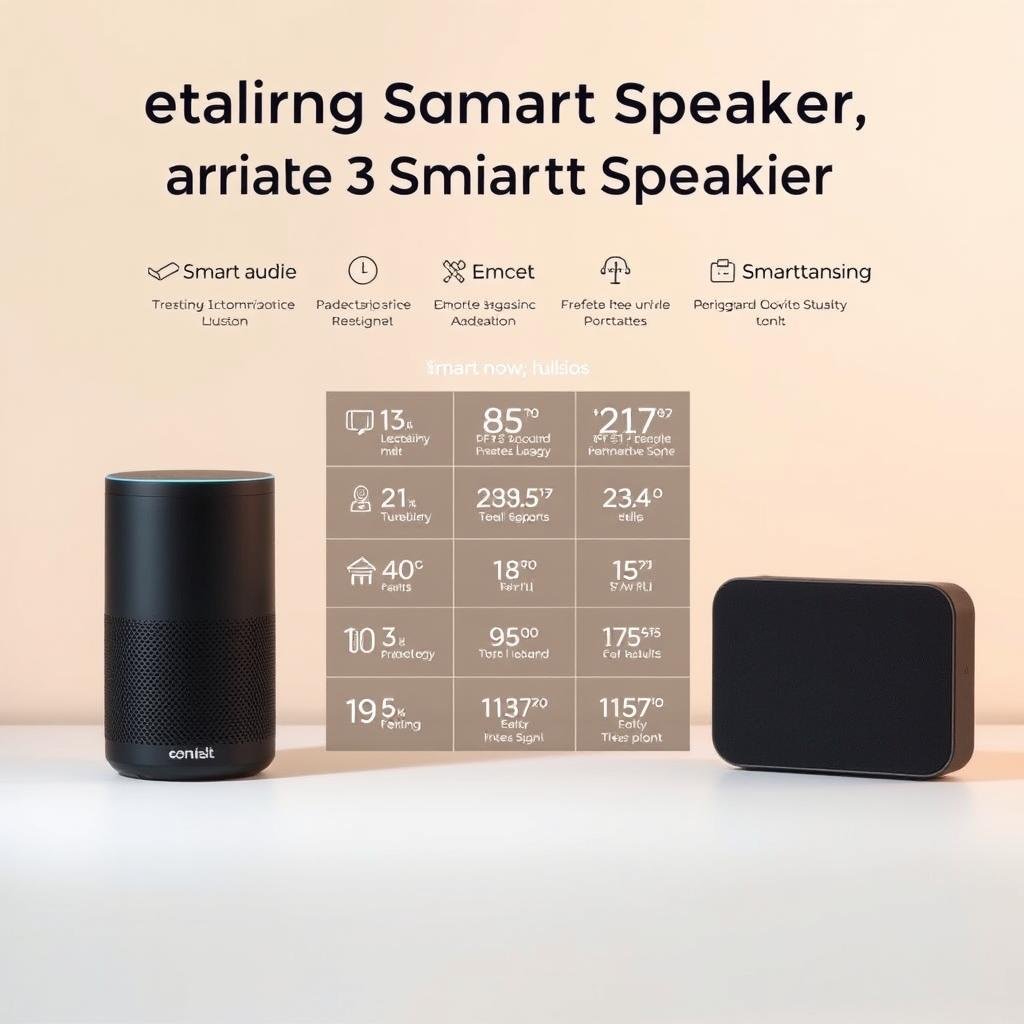
Sound Quality Comparison
The sound quality of wireless speakers varies a lot. Our tests showed how each model handles different sounds:
The Sonos Era 100 has the best sound balance. Its special tweeters make sound clear and wide. The bass is strong and controlled, even at loud volumes.
The Amazon Echo (5th Gen) has powerful bass for its size. It fills rooms with sound, but might lose some midrange clarity at high volumes.
The Apple HomePod Mini has big sound from a small body. Its smart audio tech makes sound dynamic and wide. It’s great for small spaces.
The Google Nest Audio has clear vocals and good bass. Its special woofer and tweeter make sound loud and strong. It’s best for podcasts and spoken word.
Voice Assistant Performance
The smarts of your voice assistant matter a lot. Our tests showed how Amazon Alexa, Google Assistant, and Apple HomePod with Siri do in real life:
Google Assistant is the most accurate with facts and complex questions. It understands context well and talks smoothly. It also recognizes voices well, even with background noise.
Amazon Alexa has the most skills and integrations. It might need more specific words than Google Assistant. But it’s very versatile and reliable.
Apple’s Siri focuses on privacy and working well with Apple devices. It’s not as good with general knowledge as others. But it’s fast and private with basic commands.
Smart Home Integration Capabilities
How well a smart speaker works with your home varies a lot. We looked at how well they work with other devices and how easy they are to set up:
Amazon’s Echo devices work with the most devices. They have built-in Zigbee and Matter support. Setting them up is easy with the Alexa app.
Google’s Nest system is easy to use and control. It works with fewer devices than Amazon. But it’s great for complex commands and multi-room audio.
Apple’s HomePod devices are secure but limited. They work well with HomeKit. But they’re not as compatible with other devices as others.
| Smart Speaker | Sound Quality | Voice Assistant | Smart Home Integration | Best For |
|---|---|---|---|---|
| Amazon Echo (5th Gen) | Strong bass, good volume | Alexa: Extensive skills | Excellent (Zigbee + Matter) | Smart home enthusiasts |
| Google Nest Audio | Balanced, clear vocals | Google Assistant: Best accuracy | Very good (Matter support) | Information queries |
| Apple HomePod Mini | Impressive for size | Siri: Privacy-focused | Limited but secure (HomeKit) | Apple ecosystem users |
| Sonos Era 100 | Superior balance and clarity | Alexa or Google Assistant | Good (via connected apps) | Audio quality prioritizers |
When picking your smart speaker, think about what matters most to you. If sound quality is key, choose the Sonos Era 100. For smart home control, Amazon’s Echo is best. Google’s assistant is great for natural conversation, and Apple’s ecosystem is all about privacy and security.
How to Choose the Right Smart Speaker by Room Type
Smart speakers aren’t made for every room. Each space has its own needs for the best performance. The latest smart speaker trends focus on making products for specific rooms. Knowing how to pick the right speaker for each room will make your home automation better.
Different rooms have different sounds and uses. Your kitchen needs special features, unlike your bedroom or living room. Here’s how to choose the best smart speaker for each room.
Step 1: Selecting Kitchen Smart Speakers
The kitchen is tough for voice assistants. Water, pans, and appliances make it hard for speakers to hear you.
Look for speakers with great far-field microphones. They should work well over background noise. Choose compact, splash-resistant models for kitchen counters.
Speakers with displays are great for kitchens. They let you see recipes, timers, and tutorials. The Echo Show 8 and Google Nest Hub are good choices. They have great sound and displays without taking up too much space.
- Place your kitchen speaker away from direct heat sources and splashing zones
- Choose models with physical buttons for when your hands are messy
- Look for speakers with clear volume that can overcome kitchen noise
- Select water-resistant options when possible
Step 2: Choosing Bedroom Smart Speakers
Bedroom smart speakers need to be private and gentle. They should help you relax and wake up softly.
Privacy is key in the bedroom. Look for speakers with mute switches and no cameras. You want control over when they listen.
The best bedroom speakers have soft alarms and dim displays. They should also have balanced sound that won’t wake others. The Echo Dot with Clock and HomePod Mini are good choices.
- Prioritize models with physical mute buttons or switches
- Choose speakers with adjustable night-light or clock displays
- Look for gentle wake-up features like gradual volume increase
- Select smaller models that don’t dominate nightstands
Step 3: Optimizing Living Room Smart Speakers
The living room is where you entertain. So, sound quality is most important here. New wireless audio tech makes small speakers sound big.
Choose speakers that fill the room with sound. Living rooms have many people, so speakers that work for everyone are best. Look for ones with multiple microphones.
The full-size Amazon Echo, Sonos Era 100, or Google Nest Audio are great for living rooms. They offer great sound and smart features.
- Position speakers at ear level when seated for optimal sound
- Consider stereo pairs for enhanced audio in larger rooms
- Look for models with multi-user voice profiles for family settings
- Select speakers that integrate with your TV or existing audio setup
Step 4: Setting Up Home Office Smart Speakers
The home office needs speakers that help you work, not distract you. They should work well with work tools.
Choose speakers that fit well with your work tools and calls. Clear sound is key for meetings. The right speaker can keep you focused.
The HomePod Mini and Google Nest Audio are great for offices. They work well with calendars and tools. They can help you manage your day and join calls easily.
- Place speakers within easy reach but away from microphones used for calls
- Select models that integrate with your work calendar and email
- Choose speakers with good microphones for impromptu calls
- Look for devices that support focus features like white noise or work timers
When setting up home automation with smart speakers, think about each room’s needs. Kitchens need durability, bedrooms privacy, and living rooms sound. Offices need tools integration.
By matching speakers to room needs, you’ll make your smart home better. The right speaker in the right place makes voice tech work smoothly in your life.
Setting Up a Multi-Room Smart Speaker System
Setting up a whole-home audio system with smart speakers is easier now. In 2025, devices work better together. You can enjoy music everywhere, use voice commands from any room, and make your home smarter. Here’s how to set up a multi-room smart speaker system in three easy steps.
Step 1: Assessing Compatibility Between Devices
Getting your devices to talk to each other is key. Ecosystem compatibility is the most important thing for a smooth experience. Even though cross-platform work has gotten better, sticking to one system is best.
Each big platform—Amazon, Google, Apple, and Sonos—has its own way to connect rooms. Amazon uses Multi-Room Music, Google has speaker groups in the Home app, Apple uses AirPlay 2, and Sonos has its own system.
While mixing systems is easier now, there are limits. For example, you can link some Echo devices with Sonos speakers, but you might miss out on some features.
| Ecosystem | Compatible With | Multi-Room Protocol | Limitations |
|---|---|---|---|
| Amazon Echo | Echo devices, select Sonos, Matter-enabled speakers | Multi-Room Music | Limited functionality with non-Echo devices |
| Google Nest | Nest speakers, Chromecast devices, Matter-enabled speakers | Speaker Groups | Some features restricted to Google-branded products |
| Apple HomePod | HomePod devices, AirPlay 2 speakers | AirPlay 2 | Requires Apple device for setup and control |
| Sonos | All Sonos products, AirPlay 2, Matter-enabled devices | Sonos System | Premium pricing, some features limited to Sonos app |
Think about which voice assistant you like. Google’s assistant is great at answering questions, while Amazon’s Alexa works well with more smart devices. The Google Home app makes setting up speakers easy.
“The most common mistake in multi-room audio setups is mixing incompatible ecosystems and expecting perfect synchronization. Start with a primary ecosystem, then carefully add compatible devices as you expand.”
Step 2: Optimizing Speaker Placement
Where you put your speakers matters a lot. You want good sound and clear voice commands everywhere. Room acoustics are key for sound quality.
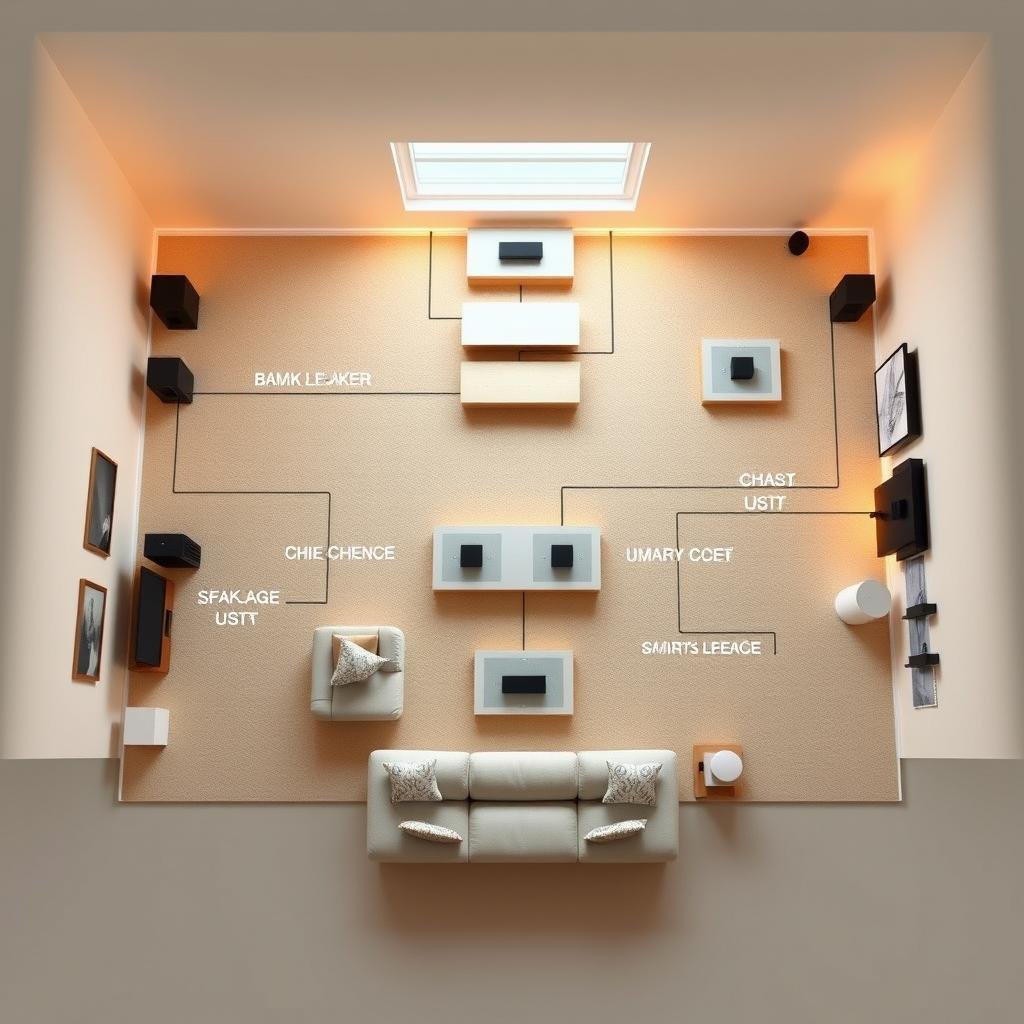
In living rooms, place speakers away from walls for better sound. Kitchens need speakers above countertops to avoid appliance noise. Bedrooms should have speakers at least 3 feet from beds for better voice recognition at night.
Consider these when placing speakers:
- Room size and shape (larger rooms may need multiple speakers)
- Common traffic patterns and where you spend most time
- Potential sound reflective surfaces (glass, hardwood)
- Distance from noise sources (TVs, appliances, HVAC vents)
- Proximity to Wi-Fi router or mesh nodes
After placing speakers, do a “walk test” by playing music and walking through each room. Look for areas where sound quality drops. Move speakers until sound is good everywhere.
Step 3: Configuring Network for Seamless Operation
A strong network is essential for your multi-room system. Network problems can cause audio dropouts and delays.
Make sure your router can handle the bandwidth. Streaming high-quality audio needs 5-10 Mbps per speaker for lossless sound. For standard quality, 1-2 Mbps is enough. A household with many speakers playing different music needs enough bandwidth.
Here are some tips for a better network:
- Put your router in the middle or use a mesh system for coverage
- Connect main speakers with Ethernet to reduce wireless traffic
- Use the 5GHz band for streaming to avoid interference
- Set up Quality of Service (QoS) on your router to prioritize audio
- Keep all devices’ firmware up to date
If you have trouble with synchronization, try these fixes:
- Restart all speakers and your router
- Move speakers closer to Wi-Fi access points
- Check for interference from other devices
- Consider adding a dedicated wireless access point for your system
Many smart speakers have network tools in their apps. Use these to find and fix connectivity issues. New models can even change their wireless channels to avoid interference.
With the right devices and a good network, your multi-room system will work great. You’ll enjoy seamless audio and consistent virtual assistant access, making your smart home life better every day.
Smart Speaker Privacy and Security in 2025
Smart speakers in 2025 are super advanced. They need top-notch privacy and security. These devices listen to us, control our homes, and keep our data safe. It’s key to know how to protect your info as much as using the tech.
Privacy has grown a lot because people care more about it. Companies now share clear policies and better security.
Smart speaker makers offer different privacy levels. Apple is the most private among big names. Its policy is easy to understand and says Siri data is just for improving the app, not sold.
Amazon and Google also share their data use plans. But they don’t promise to keep data as private as Apple does. This is important as these devices get more into our homes.
Understanding and Configuring Privacy Controls
Every smart speaker has privacy features. But knowing how to use them is key. Start by learning what controls your device has.
Big platforms offer important privacy tools:
- Physical mute buttons that turn off microphones
- Options to delete voice recordings yourself or automatically
- Voice recognition settings that only respond to known users
- Activity history controls to check and manage stored interactions
Choose privacy settings based on where your speaker is. Bedroom and bathroom speakers need more privacy than living room ones. For bedrooms, turn on voice recognition and set recordings to delete after 24 hours.
In kitchens or living rooms, you can be a bit more relaxed. Turn on voice recognition but keep recordings longer for better responses. Remember, stricter settings might limit some features.
To manage privacy across different platforms:
- For Amazon Echo: Go to the Alexa Privacy Hub in your Alexa app
- For Google Nest: Use the Google Home app’s Privacy settings
- For Apple HomePod: Configure privacy through the Home app’s settings
Implementing Smart Speaker Network Security
Privacy is just one part of the puzzle. Keeping your smart speakers safe from outside threats is also vital. Smart speakers can be entry points for hackers if not secured well. Here are steps to make your speakers safer:
- Create a separate network segment for your smart home devices. Use VLAN or a guest network on your router. This keeps smart devices away from sensitive computer data.
- Update firmware regularly on your speakers and router. Security patches are only effective if you install them.
- Use strong, unique passwords for all smart speaker accounts. Enable two-factor authentication when you can.
- Monitor for unusual activity in your smart home system. Watch for devices turning on by themselves or unknown skills being used.
By 2025, smart device encryption is top-notch, with end-to-end encryption for voice commands and data. But, third-party integrations can be risky. Always check the developer’s reputation and privacy policy before adding new features.
Network security is even more critical in multi-room setups. Make sure your Wi-Fi uses WPA3 encryption. Also, think about using MAC address filtering to only allow known devices to connect.
For families with kids, extra care is needed. Use parental controls to block unwanted purchases and limit access to mature content. Some platforms offer “kids mode” for extra privacy for young users.
By focusing on both privacy and security, you can enjoy smart speakers safely. Stay ahead of security threats by regularly checking your settings and measures.
Conclusion: Finding Your Perfect Smart Speaker Match
Choosing the right smart speaker in 2025 isn’t about spending the most. It’s about finding the perfect fit for your needs and space. Each room has its own special requirements, as we’ve explored in this guide.
First, think about what matters most to you. Do you want top-notch sound for music? Or a voice assistant that’s great at managing your schedule? Maybe you need easy control over your smart home devices? Your answers will guide you to the best speaker.
You don’t have to stick with one brand. Many homes mix different brands in each room. Your kitchen might need an Echo, while your living room is better off with a Sonos for better sound.
The top smart speakers in 2025 offer great value. They combine excellent sound, easy controls, and smart home features at good prices. Today’s wireless speakers have features that were once sci-fi.
Looking ahead, voice assistants will get even better. They’ll understand you better, work with more devices, and learn your habits. Starting with a good speaker lets you enjoy these improvements right away. You can add more as you see what really makes your life better.
The ideal smart speaker isn’t just about its features. It’s about how well it fits into your life and space.
Related: Audio Glasses
Explore our Best Audio Glasses (Fall 2025) for open-ear music, clearer calls, and smart-assistant control.





